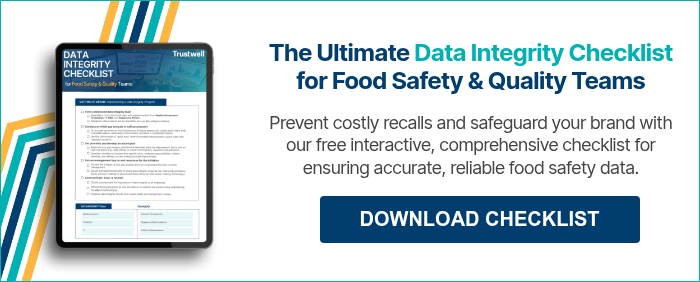For many Food Safety and Quality Assurance (FSQA) teams, everyday work can feel like drowning in a sea of information. From HACCP records and supplier audits to lab results and environmental monitoring reports, data pours in from every direction.
The sheer volume of information might suggest a comprehensive understanding of food safety, but the truth is often far more complex. It can be a challenge to extract meaningful insights, and teams too often find themselves spending valuable time on reactive problem-solving rather than proactive prevention. This can lead to critical issues being addressed only after they've escalated, missing opportunities to predict and prevent potential hazards.
Listen In: Future Trends in Food Safety with Brando Tijerina of Taco John’s
A decade ago, food safety was often seen as a compliance-driven task, a series of boxes to check. Today, it has transformed into a continuous, data-rich, and risk-based discipline. The fundamental question has evolved from "Did we meet the requirement?" to "Can we prove it, instantly and with confidence?".
At the heart of this evolution is data integrity. A well-defined food safety data strategy is no longer a "nice-to-have" but an essential tool for proactive FSQA, ensuring compliance, and creating a significant competitive advantage. It's about having complete, accurate, and trustworthy data across the entire lifecycle of a food product, from farm to fork.
Why Your Old Approach to FSQA Data is Holding You Back
 It Relies on Disconnected Data
It Relies on Disconnected Data
One of the most significant hurdles in achieving robust food safety is the pervasive issue of disconnected data. Information often remains trapped in disparate systems like ERPs or countless spreadsheets, none of which communicate effectively with each other. This fragmentation creates data silos, leading to a severe lack of visibility across the supply chain.
Read More: The Essential Guide to Supply Chain Risk Management
Without a unified view, FSQA teams face delayed response times when issues arise and an incomplete picture of their overall food safety performance. It's akin to "flying blind", making critical decisions based on faulty or incomplete information, which can lead to delayed recalls, non-compliance fines, and lost consumer trust. Imagine a scenario where a supplier mislabels an allergen, and your internal records show the ingredient as clean; this "paperwork error" can quickly escalate into a life-threatening Class I recall.
It Never Moves Beyond Simple Compliance
The traditional mindset of collecting data primarily for compliance's sake, as an episodic, check-the-box task, misses a crucial opportunity. While meeting regulatory requirements is essential, this reactive approach prevents organizations from leveraging their data for continuous improvement and operational excellence. It limits food safety to a historical record rather than a predictive tool.
Consider this: Food recalls cost the average company $10 million in direct costs, not including the long-term damage to brand reputation and sales. A proactive approach to food safety, powered by robust data management, can significantly mitigate these risks and associated costs.
The 3 Pillars of a High-Performing Food Safety Data Strategy
Building a high-performing food safety data strategy requires a foundational shift in how organizations perceive and manage their information. It moves beyond mere data collection to encompass sophisticated analysis and actionable insights.
Pillar 1: Centralized & Standardized Data Collection
The first pillar involves establishing a system for centralized and standardized data collection across the entire food product lifecycle, from farm to fork. Key data points to collect include environmental monitoring swabs, supplier compliance records, internal audit scores, and customer complaint data. The emphasis here is on digital data capture and standardized formats to minimize manual errors and ensure consistency.
Innovations such as sensor-driven traceability, utilizing technologies like RFID and ambient IoT, can provide a persistent digital thread to follow a product's journey, capturing data automatically as it moves through the supply chain. This level of automation reduces human error and ensures real-time data validation.
Pillar 2: Advanced Analytics & Predictive Insights
Moving beyond basic reporting, a robust food safety data strategy embraces advanced analytics and predictive insights. This means leveraging tools and techniques to identify patterns and anomalies that might signal a future food safety event. For example, instead of just recording temperature deviations, a robust data strategy analyzes trends to predict when equipment is likely to fail, enabling preemptive maintenance.
Webinar: Future-proofing Food Technology: The Evolution of Data, AI & Tech Stack Optimization
Artificial Intelligence (AI) plays a crucial role here, helping to add critical context and automatically flag when something doesn't align with historical patterns or regulatory norms. The goal is to make data validation an autonomous, self-healing process, where AI agents can contextualize and validate data in real-time, stripping human error from the process. This prevents compliance problems before they even start.
Pillar 3: Actionable Visualization & Reporting
Data is only valuable if it can be understood and acted upon. Therefore, the third pillar focuses on actionable visualization and reporting through user-friendly dashboards for FSQA teams. These dashboards should provide real-time performance against Key Performance Indicators (KPIs), supplier scorecards, and even hotspot mapping for contaminants. Visualizing data in an accessible format empowers teams to quickly identify trends, make informed decisions, and respond swiftly to potential issues.
AI-driven analytics are transforming inventory recommendations for grocery retailers, enabling precise calculations of optimal product quantities and significantly reducing food waste associated with excess stock. By evaluating historical sales patterns, AI solutions equip food distributors with enhanced visibility into item performance and purchasing cycles, resulting in more strategic and efficient procurement. According to a 2022 industry report, AI implementation led to a 14.8% decrease in grocery store food waste per location.
Putting Your Data Strategy into Action: A 5-Step Plan for FSQA Teams
Getting a solid food safety data strategy in place is more than a technical task. it's a team effort that needs a clear plan and buy-in from everyone involved. For it to truly work, you need different departments to collaborate – think your food safety and quality assurance (FSQA) folks, IT, operations, procurement, and even your top executives. This way, everyone's on the same page, and the strategy fits with your company's main goals and what regulators require. Crucially, when leaders are on board, it helps create a culture where data management is a priority, and it ensures your team has the resources they need to keep those data initiatives going strong.
Step 1: Assemble Your Cross-Functional Team
Success hinges on collaboration. It is crucial to involve not only your FSQA team but also representatives from IT, operations, and procurement. This ensures that the data strategy aligns with broader business objectives and that the technological infrastructure supports the data needs of food safety.
Step 2: Define Your Key Food Safety Objectives
Before diving into data collection, clearly define what you aim to achieve. Are you looking to reduce the incidence of a specific pathogen, improve supplier reliability, or decrease customer complaints? Establishing clear, measurable objectives will guide your data collection efforts and provide benchmarks for success.
Step 3: Conduct a Data Audit
Perform a thorough audit of your current data landscape. Identify all existing data sources, their formats, and any gaps in the information being collected. This audit will reveal where data silos exist and highlight areas for standardization and integration. Many organizations are grappling with legacy systems not designed for today's data demands.
Step 4: Select the Right Technology Stack
Choosing the appropriate technology is critical. Consider Quality Management Systems (QMS) that offer robust data management capabilities, alongside dedicated data analytics platforms. Look for solutions that are cloud-native, API-first, and interoperable by design, allowing for flexibility and speed in data exchange. The right technology should provide a clear history and audit trail for every event, label, or ingredient, enabling traceability and rapid recall response.
Buyer's Guide: Future-Focused Food Tech: Key Drivers and Trends
Step 5: Implement, Train & Iterate
Implementation is an ongoing process. Once the new systems are in place, invest in comprehensive training for your team to ensure they can effectively utilize the new tools and understand the importance of data integrity. Continuously refine your strategy based on the results you observe, adapting to new challenges and leveraging emerging technologies. The aim is to make data validation an autonomous, self-healing process.
The Competitive Edge: How a Strong Data Strategy Drives Business Value
Investing in robust data systems before a crisis or mandate forces your hand provides a powerful strategic advantage. Companies that do this aren't just checking boxes; they're using data as a competitive asset.
Benefits:
- Better Brand Reputation: Demonstrating a commitment to data-driven food safety builds trust with consumers and B2B partners, helping establish a reputation for security and reliability
- Operational Efficiency: By spotting trends sooner, streamlining audits, and lowering compliance costs, organizations can reduce waste, prevent costly recalls, and optimize their processes
- Stronger Supplier Relationships: Using data to collaborate with and manage suppliers more effectively leads to improved quality and reliability throughout the supply chain
A strong data strategy is foundational to the entire business. If your data isn’t accurate, your labels might be wrong, your recall response won’t be fast enough, and your sourcing strategy will remain reactive instead of predictive. High-integrity data leads to faster decisions, fewer surprises, and a valuable reputation.
The journey from data chaos to a strategic, competitive advantage in food safety is within reach. By embracing a modern food safety data strategy that prioritizes centralized collection, advanced analytics, and actionable
visualization, FSQA teams can transform their operations. This proactive approach not only ensures compliance and
reduces risks but also positions your organization for greater efficiency, stronger partnerships, and an unshakeable
reputation for safety and quality.
Ready to build your own food safety data strategy? Trustwell can help. Get in touch today to schedule a custom demo.
Tag(s):
Food Safety
Theresa Rex
Theresa Rex is Trustwell's Digital Marketing Manager. She has over two decades' experience researching, writing, creating, and marketing content for curious readers and leaders online. A former food and lifestyle writer, Theresa joined Trustwell in 2024.
Other posts you might be interested in
View All Posts
Food Industry
8 min read
| June 29, 2023
How to Harness Supplier Data to Improve Food Safety Efforts
Read More
Product Formulation
9 min read
| September 15, 2025
A Recipe for Success: Better Version Control for On-Time Product Launches
Read More
Food Industry
17 min read
| November 13, 2025



